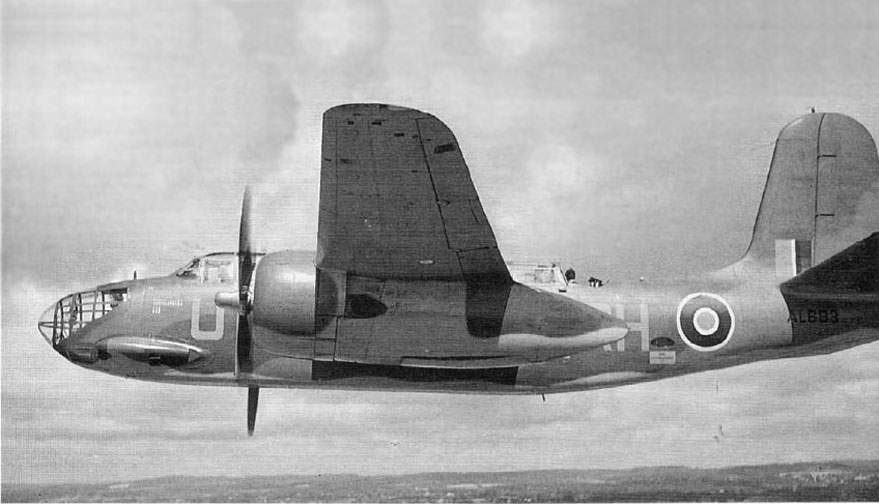 |
Drawing A-20C (Boston III) with russian UTK-1 turret
|
 |
Drawing A-20 G-20
|
 |
Boston AL693 'U' flown by F/L Johny Reeve and his crew on the Eindhoven raid. This photograph, taken during a practice flight just prior to the raid, shows WOP/AG (Wireless Operator/Air Gunner) Jim 'Dintry' Moore in the rear gun turret with F/O 'Skeets' Kelly, who took photos of the raid from this aircraft. AL693 flew 31 sorties in 88 Sguadron between 23 March 1942 and 3 January 1943 before going to North Africa. In later served with 114 Squadron and was lost in a crash landing on 17 September 1943. (IWM)
|
F-3 Night Reconnaissance Aircraft
Reconnaissance version of the A-20 "Havoc" medium bomber. The first prototype of the reconnaissance aircraft, the XF-3, was built in March 1940.
In January 1944, the Daggett modification center began a trial conversion of the Douglas A-20J bombers. Serial revision was carried out since July 1944. A total of 46 F-3A based on A-20J and A-20K bombers were produced.
The F-3A was in service only with the US Army Air Force, since May 1944.
YF-3 since 1942 was used for aerial photography in Alaska by the US Army Cartographic Service. F-3A from May 1944 until the end of the war operated at the front in France and Germany. The 155th night reconnaissance squadron flew on them. The A-20B bombers also served as scouts; they were used by American units in England from the fall of 1942.
In the USSR, in large numbers, aircraft of the Boston III and IIIA modifications (originally intended for the British Air Force and differing in equipment and weapons), A-20B, A-20C, A-20G, and later also A-20J were converted into reconnaissance aircraft and A-20K, installing additional gas tanks (in the bomb bay) and photographic equipment (in the bomb bay and the gunner's cockpit). On the A-20B and A-20C aircraft, sometimes the weapons were replaced with domestic ones. There were many options for the configuration and placement of cameras. We used to call all these machines in the English manner - "Bostons".
The first scouts based on the A-20 began to operate in April 1942 in the Caucasus. Since the summer of the same year, they were used by both land and naval aviation on various fronts and fleets. The converted vehicles were part of the long-range reconnaissance regiments of the Supreme Command Headquarters (strategic reconnaissance), individual reconnaissance regiments and squadrons, and conventional bomber regiments.
The first case of widespread use of scouts based on the A-20 was shooting the positions of the Germans before the offensive at Stalingrad. Later they were used in Belarus, Ukraine, Karelia and the Baltic states.
In the A-20 naval aviation, they served as scouts since May 1942, when a freelance reconnaissance squadron was organized in the Black Sea, which included A-20B and Boston III vehicles. From February 1943 they appeared in the Baltic, and from March of the same year - in the Northern Fleet. In May 1943, one of the North Sea "Bostons" photographed the port of Narvik in Norway for the first time.
In the final phase of the war, these aircraft actively photographed objects in the deep rear of the Germans. They filmed Constanta, Sulin, Ploiesti, Warsaw, Bucharest, Athens, Belgrade, Budapest. Sometimes bombing strikes were carried out along the way. By the end of World War II, vehicles converted from A-20 bombers were the most massive type of long-range reconnaissance aircraft in the Soviet Air Force. They took part in the preparation of the Berlin operation in March - April 1945 and in the hostilities in the Far East in August of the same year. The aviation of the Pacific Fleet received A-20K reconnaissance aircraft in mid-1945. During the war with the Japanese, they filmed the southern part of Sakhalin, the Kuril Islands and Japan itself - about. Hokkaido.
Production of the F-3A was stopped in September 1944.They were removed from the armament of the US Air Force at the end of 1945.
Advanced
Bibliography

- "Bostons in USSR" /Vladimir Kotelnikov/
- "Encyclopedia of military engineering" /Aerospace Publising/
- "American warplanes of World War II" /under cor. David Donald/

|






